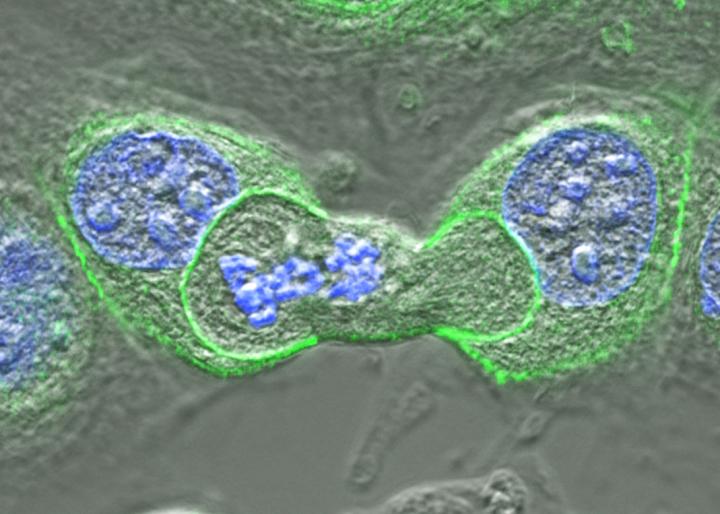

A cell in the process of dividing (centre) that is being engulfed by cells on either side. DNA is shown in blue and a protein responsible for attachment between cells is shown in green.
Credit: Dr Jo Durgan, Babraham Institute
Cell cannibalism, also called entosis, occurs when one cell surrounds, kills and digests another. Entosis doesn't typically happen between healthy cells but it is common in tumours. This latest research, published in the journal eLife, reveals that cannibalism can be triggered by cell division; when one cell divides to form two. Since uncontrolled cell division is a key hallmark of cancer, this suggests that cannibalism may have a role to play in resisting cancer.
The research, which also includes scientists from Memorial Sloan Kettering Cancer Centre, USA and the Francis Crick Institute in London, examined human epithelial cells. These cells form many of the surfaces in the body and give rise to over 80% of human cancers. Normally, epithelial cells remain firmly attached to their surroundings when they divide. This study shows that weakened attachments result in more cell cannibalism. This may explain why drugs that weaken cell attachments are effective anti-cancer drugs.
First author on the paper, Dr Jo Durgan, said: “We set out to identify the proteins that control cell cannibalism in tumour cells, but by using time-lapse microscopy to watch this process in action, we stumbled across a completely unexpected new mechanism. The link we've found to cell division is really intriguing from the perspective of cancer.”
Cell cannibalism has a complex relationship with cancer and it is not totally clear whether it helps or hinders tumour growth. However, the discovery that dividing cells are more likely to be cannibalised by other cells suggests that entosis may help to slow or prevent cancer by causing cancer cells to be consumed and destroyed by nearby healthy cells.
Lead scientist on the paper, Dr Oliver Florey, said: “Entosis is a fascinating process that may play a role in normal physiology, as well as cancer. By studying entosis, we hope to gain insights into fundamental cell biology, as well as to explore intriguing new avenues for cancer research. After 100 years of observing 'cell-in-cell' structures, there is now an exciting push towards discoveries in both cell and cancer biology.”












